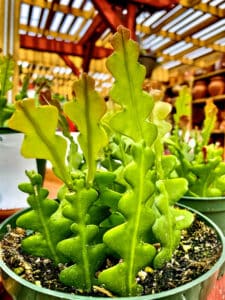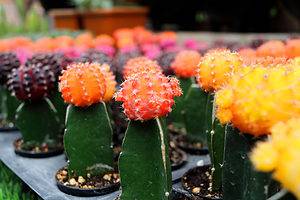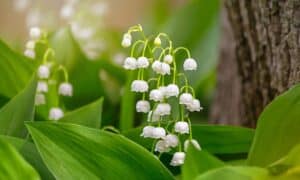The date palm is a tropical tree best known for producing the delicious and world-beloved fruit known as the date. However, date trees are also quite aesthetically pleasing and are often used for landscaping purposes and as houseplants.
Let’s take a look at some more information about this fascinating palm, and break down the basics of how to care for your own date palm.
What is a Date Palm?
The date palm is a member of the Arecaceae family and is classified as Phoenix dactylifera. It is a species of flowering plant that has been cultivated for centuries throughout the Middle East, parts of Africa, and southern Asia. Today, it has been naturalized in most tropical regions of the world. The plant is known for having arching greyish fronds and lots of yellow flowers that appear in the springtime. This particular species is very slow-growing and only grows a few feet annually.
Date trees can grow alone or in clumps with several branches from a single root system, reaching heights of up to 100 feet and can be as wide as 40 feet. They grow slowly and, with appropriate care, may live for more than a century. This species can be grown outdoors in USDA hardiness zones eight through 11.
Date fruits, also known as dates, are oval-shaped, one to three inches long, and approximately an inch in diameter. Depending on the type, its color can range from dark brown to brilliant red or yellow. Dates are extremely sweet and are eaten as dessert on their own or in confections.
Dates have been grown for a very long time throughout the Middle East and the Indus Valley. The Middle East and northern Africa are the main producers and consumers of dates, accounting for over 8 million metric tons of the entire annual world production. Dates are also symbolically significant in the Muslim, Christian, and Jewish religions.
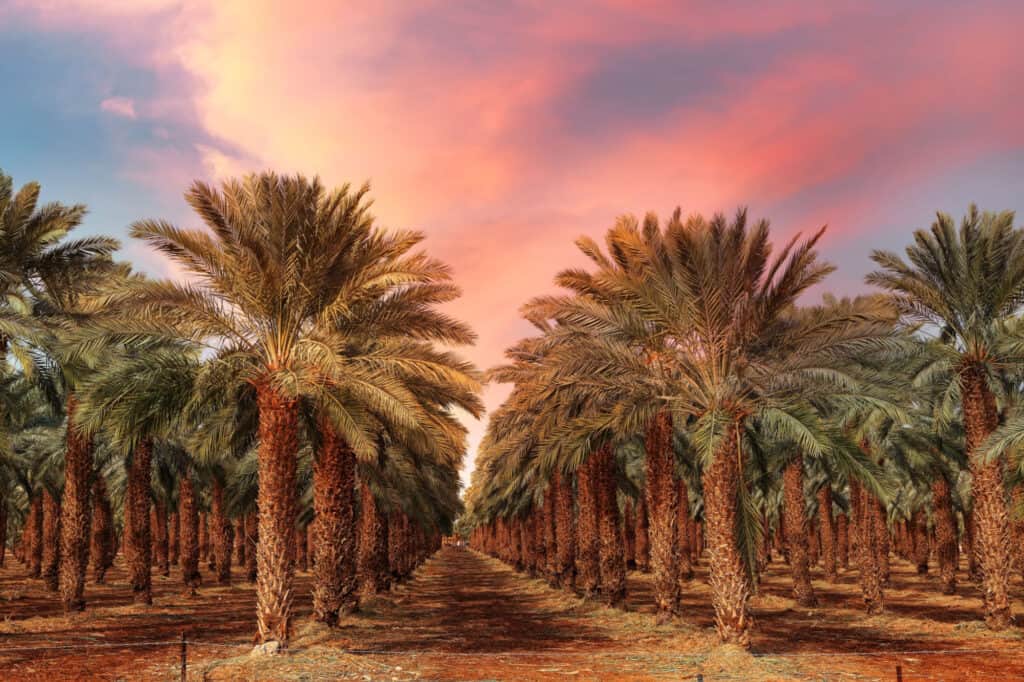
Date palms (pictured) have been grown commercially for their fruits for centuries.
©Protasov AN/Shutterstock.com
How to Care for Date Palm Trees
Male and female date palm trees are distinct, and only female plants produce fruit. At least one male plant should be present for every six female plants if you want to grow dates. Pollination is accomplished via the wind.
The date palm can withstand drought, especially once it has grown and become more stable and hardy. Nonetheless, it requires consistent hydration during its blooming and fruiting season to yield a robust harvest. Also, young trees require more water than adult trees do. Don’t let the soil completely dry up, but also don’t let it become wet. Root rot can hurt most plants, especially palm species.
These palm trees favor warm, dry, and sunny weather. In fact, pollination cannot take place until temperatures reach approximately 95 degrees F. The date palm can withstand temperatures as low as 20 degrees F. Any temperature lower than that can harm the fronds or possibly kill the tree entirely. The fruit of the date palm thrives in dry heat as well. Rotting can result from an excess of moisture and humidity.
The date palm enjoys a lot of sunlight, which is in keeping with its ideal dry, hot environment. Although it can handle some mild shade, giving it access to full sun or at least six hours of direct sunshine most days is preferable.
The most crucial aspect to take into account when deciding where to grow your date palm is well-draining soil. This palm tolerates salinity and grows well in sandy or loamy soil. It prefers an alkaline to slightly acidic soil pH. Manure is a great choice for date palm fertilization. It is advised to use specialized palm tree fertilizer if you would prefer to purchase packaged fertilizer. To prepare the tree for the production of flowers and fruit in the following months, fertilizer should be applied in late winter or early spring according to the directions on the package.
Tips for Maintaining a Date Palm Tree
As we mentioned earlier, date palms thrive in full sun and rich, well-drained soil. For this plant, deep, consistent moisture is ideal. Date palm plants can withstand drought if they have a strong foundation. Certain date palms have the potential to naturalize to the point of being invasive if their environment is ecologically perfect for them and they receive some assistance from nearby lakes, streams, or birds.
It’s recommended to transplant date palms in the spring or the fall. Due to the specimen’s delicate wood, transportation it should be done with caution. To avoid the leaves falling off throughout the procedure, support the palm’s crown at all times. Dig the hole twice as wide as the root ball, just like you would when planting any other tree. Fill up the area surrounding the tree with the loose soil you dug up, just covering the roots. Using your hands or feet, compact the earth around the roots before thoroughly watering. Early in the spring, feed your date palm with a top dressing of manure or use a potassium-rich fertilizer for palm trees.
Palmetto weevil infestations, which are attracted to date palm trees when leaves are removed by trimming or after transplanting, can cause the trees to die. Older leaves are where the weevils deposit their eggs, and the ensuing larvae eventually destroy the tree by tunneling deep inside it. Before the weevils have an opportunity to establish themselves, treat damaged leaves with a pesticide.
How to Grow Date Palm Trees Outside
Date palms can be planted in either early spring or fall. Plant your date palm on a day that’s not too windy if you’ll be transplanting a tree rather than beginning from scratch. Otherwise, as it is relocated, the tree can experience harm to its fronds.
Choose a location with sufficient room to accommodate the tree’s full size. The soil should drain well and the tree should receive a lot of sunlight. Make sure that when a baby palm grows, it won’t be overly shaded by adjacent plants. It’s also possible to cultivate immature palm trees in containers outside as well.
To plant your date palm outside, make a hole that is twice as large and a little deeper than the root ball of the palm. Also, remember to consider a mature palm’s 30 to 40-foot spread when deciding where to place it in relation to other plants and buildings. In most cases, a support structure won’t be required, although you might wish to shield a baby palm from severe winds until its roots take hold in the soil and become more stable.
How to Grow Date Palm Trees Indoors
A juvenile date palm can be grown in a pot indoors. This makes it possible to transfer it into an area with ideal lighting. Use a container that is just a little bit bigger than the root ball of the palm. The best container for an indoor date palm is one made of unglazed clay, such as a terracotta pot, which has drainage holes and allows extra moisture to escape through its porous walls. Fill the container with a palm potting soil that drains well. From there, the care requirements for this plant are the same as they would be for outdoor date palms.
How to Propagate a Date Palm
The suckers, or offshoots, that develop at the base of date palms’ trunks make it easy to propagate and grow multiple plants. The following method of propagation not only saves you money on a new plant but also allows you to have a fruit-bearing plant sooner than if you were to start from seed.
To start, find a thriving offspring. Try to keep as many of its roots attached as you can when you gently detach it from the parent plant. Doing this by hand is the most straightforward option. Put the branch in a pot with palm soil or immediately into its permanent garden position. Just around its roots, gently compact the earth. Remember to evenly hydrate the soil, but avoid letting it become soggy. Once the new tree’s roots take hold, keep the new plant out of direct sunshine. Stakes can also be necessary to help it grow straight as it takes root in the soil.
Outside of propagation, you can also grow date palms from seed. To start, pick a bunch of ripe dates and push the seeds out of them. Soak the seeds for about a day and discard any seeds that rise to the top after soaking. Put each viable seed in a separate, tiny container with seed-starting mix. So that they are about halfway covered, press the seeds into the soil. Put the containers in an area that receives bright and indirect sunshine. For added moisture retention, you might wish to put a plastic bag on top of the containers. Keep the soil warm and very damp. In about a month, germination should occur and the new date plants can be transplanted.
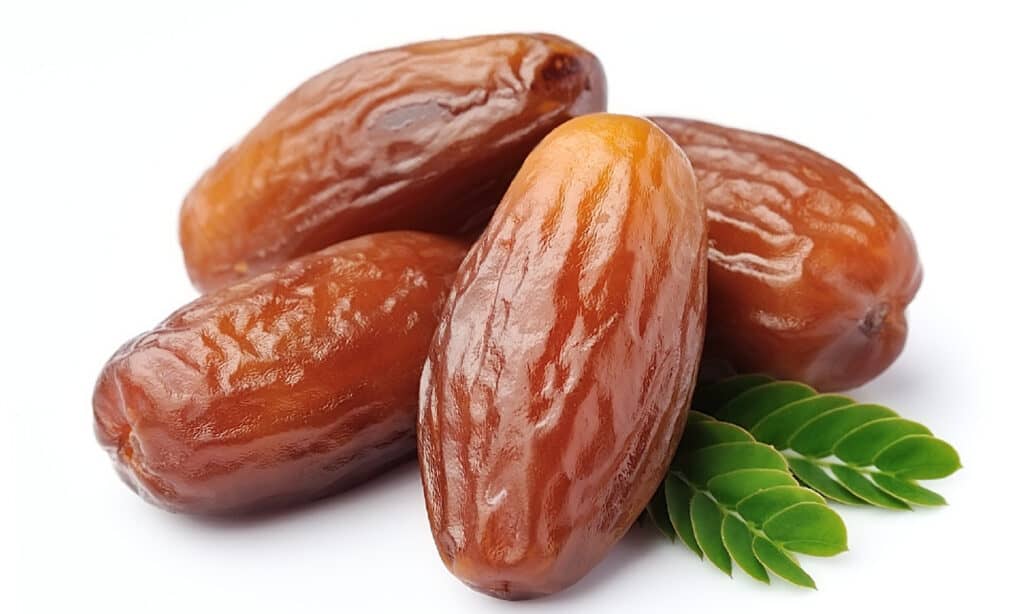
Propogation makes it possible to get date fruits (pictured) sooner than if you start from seed.
©iStock.com/Volosina
When Can I Harvest Dates From My Date Palm?
Late summer to early fall is when date fruits start to mature, although not all of the bunches will ripen at the same time. The first harvest from a young tree should provide about 15 to 20 pounds of dates; older plants can yield hundreds of pounds of dates. Cut off the cluster with a sharp knife once the fruits are mushy and brown rather than green. They can be kept in a refrigerator for up to six months or at room temperature for approximately a month in an airtight container. Date fruits are also freezer-safe for a year. Consume them fresh, in smoothies, baked goods, and other dishes. Be cautious not to consume the pit inside of date fruits, as they are not particularly edible.
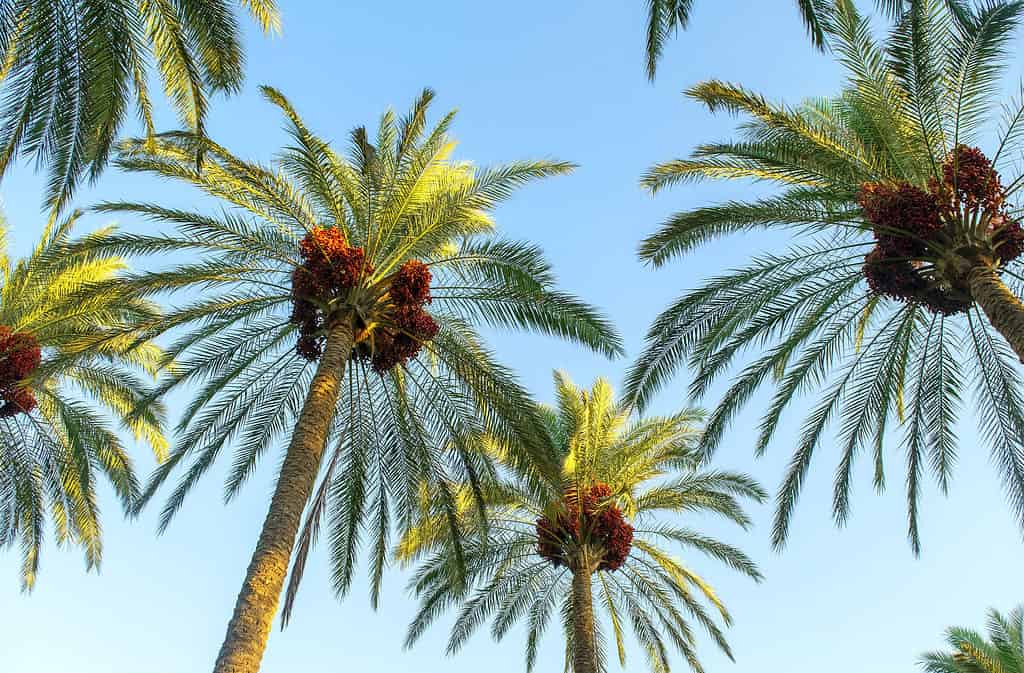
Date palms (pictured) can yield hundreds of pounds of date fruits,
©iStock.com/Viktoriya Fivko
Can I Prune My Date Palm?
With the exception of removing damaged or diseased fronds, this tree seldom has to be pruned. In order for the tree to focus its energy on the main trunk, you can cut back any offshoots that start to sprout around the base of the trunk. Also, when your tree starts to develop more fruit bunches, it’s advised to trim the unripe bunches to improve airflow around the maturing fruits and prevent fruit rot. The fruit size for your yield can also be increased by thinning the bunches.
While your home-grown date palm might not produce the tasty fruit it is known for indoors, it is still a very lovely plant that looks beautiful in tropical settings and indoor spaces. If you can handle caring for this unique plant, then you’ll be able to enjoy this plant for many, many years.
The photo featured at the top of this post is © iStock.com/Woodkern
Thank you for reading! Have some feedback for us? Contact the AZ Animals editorial team.



